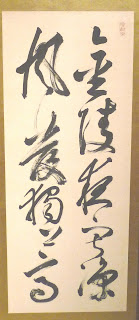The Confucian Scholar

Nukina Kaioku (1778-1863)
was a Confucian scholar
who lived in Japan.
Which meant that he was destined
to be a teacher instead of a high official.
And apparently
these screens were used
in his school
to exemplify higher learning
(the text are poems by Li Bo and Su Xiang) Until I saw the Bamboo Forest
Until I saw the Bamboo Forest
these were my favorite screens in the soon-to-close exhibit
at the Art Institute.
But, it's not really fair to compare them.
In the Bamboo Forest, every mark contributes to a spatial illusion.
But the only space on these screens
is that which surrounds each separate character.
They may be wonderfully arranged on the page
(they are)
but it's still just a collection of (wonderful) details
It's like the difference between a symphony
and a sequence of jazz improvisations.
or maybe "wonderful"
is not a strong enough word?
The fat and the thin of it.
It's all too exciting.
The characters are Chinese,
but can't you hear the Japanese accent?
(i.e.-- a flair for elegant drama)
If you wanted to learn Chinese culture in Japan,
wouldn't you want to study with this man?
at least,
you would have fun.


















